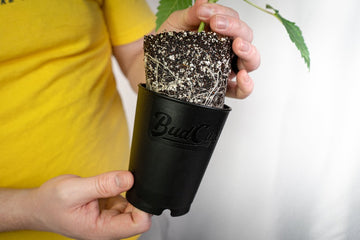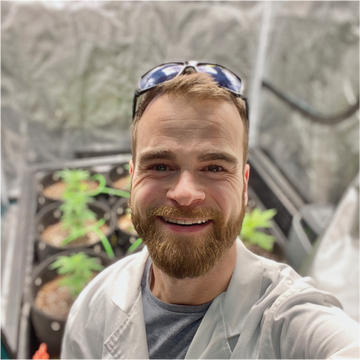The BudTrainer Method™ Lesson #1
How to Plant & Germinate Hemp Seeds
Written and edited by Henrique Dias on May 4, 2024

DISCLAIMER: Everything taught and sold by BudTrainer is to be used strictly for legal purposes. We condemn the production of illegal substances and it is your duty to ensure that you are complying with the law. The words "hemp", "cannabis", "weed", and "marijuana" are used interchangeably to refer to the same plant (legal hemp with less than 0.3% THC) for the purposes of this lesson.
Germinating Cannabis Seeds for a Strong Uptake
Mastering the planting and germination phase of your plants is essential for a healthy and bountiful harvest. If done improperly, your seeds may never germinate, or worse - they will germinate but die later on, or give you a stunted plant. We know this all too well because we've lost our share of seeds over the years, and then took to plant science and commercial cannabis production standards to create a method (and a product) to ensure your planting is as smooth as possible. Welcome to BudTrainer’s Lesson #1, where you will learn how to plant and germinate like a pro.

Tools & Materials
Essential
- The BudCups™ or other perforated 16 oz container
- A transparent cup or dome to cover the top
- Tap water or RO/distilled water (if using fertilizer)
- Soil, coco coir, or other media of preference
Upgrades
- Veg stage cannabis nutrients for faster uptake
- Feminized seeds to guarantee female plants
- Mycorrhizal fungi for root development
- Indoor grow light for seedlings (CFL)
How To Germinate Marijuana Seeds
Step 1
Prepare Your BudCups™ Or Starting Container
Drop the bottom plate inside your BudCups and make sure it sits flat at the bottom, with the convex, shiny end facing up. This is very important, as the bottom plates are made on an angle to allow for the tripe-drainage mechanism to work. This means your roots will be automatically pruned at the bottom, and never waterlogged. If you don’t have the BudCups, choose a container around 16oz of volume, and make sure that the bottom is perforated to allow water out and prevent root rot. Containers with poor drainage are tricky because they will let your plant grow, but very slowly.


Step 2
Fill With Soil Or Other Media
Fill your BudCups with soil, coco coir, or media of preference, up to the top rim. Make sure to break down any dense chunks of soil and never pack your soil down, as your roots need oxygen in order to thrive. Loose soil creates oxygen pockets for your roots to grow into, and if those pockets are closed, they have nowhere to grow.


BudTip: Use Mycorrhizal Fungi To Grow Bigger Roots

Mycorrhizal fungi is a commonly used supplement for cannabis plants as it helps your roots intake more nutrients, thus allowing you to grow bigger plants. This fungus called Mycorrhizae creates a mutualistic relationship with your roots, where it absorbs more nutrients from the soil in exchange for some sugars from your plant. Working together, they create massive root structures that take your plants to the next level.

To add mycorrhizal fungi to your media, just blend it into the top of your soil, mainly around the center area where the seed will be planted. This will create the perfect "bed" for your seed. We recommend PRO-MIX® CONNECT™, which is what we use on all of our plants at BudTrainer - it’s super easy to use and works like a charm.
Step 3
Water Your BudCups™ Before Planting
The best time to water your media is before planting, so that you don't disturb your seed with the water once it's planted. Using 150ml (5oz) of dechlorinated tap water or distilled/RO water mixed with your vegetative stage nutrients, moisten the soil slowly (ideally, over 60 seconds), until a small amount of runoff starts coming out of the raised bottom. This means your BudCups are fully saturated and your seed will grow its roots over the next 2 weeks in search of all that water, thus growing in all directions. If you are not sure which fertilizer to use, we highly recommend Athena's Blended Line - it’s what we use at BudTrainer, and they have a very easy-to-follow recipe.


Step 4
Plant Your Seeds
- Make a small ¼" deep hole in the center of your BudCups.
- Place your seed into the hole, with the pointy end facing down and the crown facing up.
- Cover with a small amount of media. This will allow your seed to germinate in 2 to 4 days.
If you don’t have seeds yet, here at BudTrainer we only use seeds from Seedsman, the most reputable seed bank in the world, with germination-guarantee on all seeds. They are great friends of ours, and if you use the coupon code BudTrainer, you will get 10% OFF your seeds.



Step 5
Cover Your Seedlings
Young seedlings need high-humidities to thrive, until they are old enough to withstand dryer air. To accomplish this, you can build your own dome by using a simple transparent plastic cup with 2 holes cut at the bottom and 1 hole cut at the top, flipped upside down, on top of the media. The perforated dome will ensure the humidity stays at around 80% inside, while still allowing the light to come through.
You can remove the transparent cup once the seedling reaches the top, or once the leaves start touching the sides. At this point they will be strong enough to continue growing in the dryer outside environment.


Step 6
Add Warmth & Light
Marijuana seeds love some extra warmth to germinate, so try to keep the temperature between 70-79°F (21-26°C) around your seedling. If it’s too cold where they are, you can add a heat mat under your BudCups. And if you are looking for one, we use the heat mats and indoor grow lights by AC Infinity, which are the most reliable electronics in the market.
Speaking of which, it is also essential to provide 18-20 hours of light per day. You can do this by using a 30W indoor grow light (preferably a CFL light), an LED light at the lowest setting, or you can grow your seedling on a sunny windowsill - just make sure that your germinated marijuana plant gets a lot of light during the day - ideally more than 8 hours of direct sunlight and 8 hours of indirect sunlight.

You Are Off To A Great Start
Now that you have planted your seeds and created the perfect environment for them to thrive in, it's time to wait for them to sprout, which typically happens between 2 and 5 days from planting. However, if your seed hasn't germinated after 5 days, add a little more water over top of it, and wait another 2 to 5 days. If it hasn't germinated by then, it's time to plant another one, as your seed is likely a dud.

How To Deal With Lanky Seedlings
If your seed doesn’t get enough light, it will grow tall and lanky, and eventually fall over, which is far from ideal. When this happens, simply use a piece of BudHuggers to hold it upright - stick one end inside your media, halfway down the BudCups, and then twist the top to form a ring that can hold the main stem upright. Lastly, increase the amount of light your seedlings are exposed to and they will start widening instead of growing tall.
Behind the Leaves: Why Not Plant in the Final Pot?
The reason why we don’t plant our cannabis seeds directly into their final containers is because they end up developing weaker root structures than if we transplant them. Here is why.

When your seeds start in the BudCups, the tap root (the main root that comes out of the seedling) reaches their edge within a couple of days, which forces more roots to be produced from the center of the rootball. This allows for multiple root tips to form, so that when the young plant is transplanted into the next pot, those root tips are ready to shoot out and grow in every direction.

Conversely, if you were to plant your seed in the final container right away, the tap root would grow all the way to the bottom, and root tips would only form around the bottom because that is where the water stays after each watering session.
#BROBusters: Why You Should Ditch The Paper Towel Method
The paper towel method is a technique used by some cannabis growers to germinate seeds before planting them in soil. The process involves placing seeds between damp paper towels until they sprout in 1 or 2 days, after which they are transplanted to soil.

While the paper towel method can work for some, it is risky for several reasons. For one, if the germinated seedling is left in the paper towel for too long, the root can become tangled and potentially damaged during transplanting. Not to mention, it will not grow downward as it should, and will take some time to find its way.
Additionally, the paper towel method can expose the seed to contamination or infection, which can lead to poor germination rates or stunted growth. Planting directly in soil reduces the risk of infection and provides a more stable environment.
Overall, while the paper towel method can work, we find it is a waste of time. Planting directly in soil can be a simpler and more reliable method for germinating cannabis seeds, and can help them sprout healthier and stronger.
Learn to Grow Big Buds
And be the first to hear about new articles, product releases, and special events.
About the Author

Henrique, the CEO of BudTrainer, is a mechanical engineer with a commercial cannabis production post-grad, and is also a former commercial cannabis consultant.
H takes plant science principles and breaks them down into simple steps for home growers to achieve the same results as the pros and grow the highest-quality cannabis.
The BudTrainer Method™
Continue Learning

The BudTrainer Method™
Basics
How to Select Hemp Seeds
How to Select Hemp Seeds




